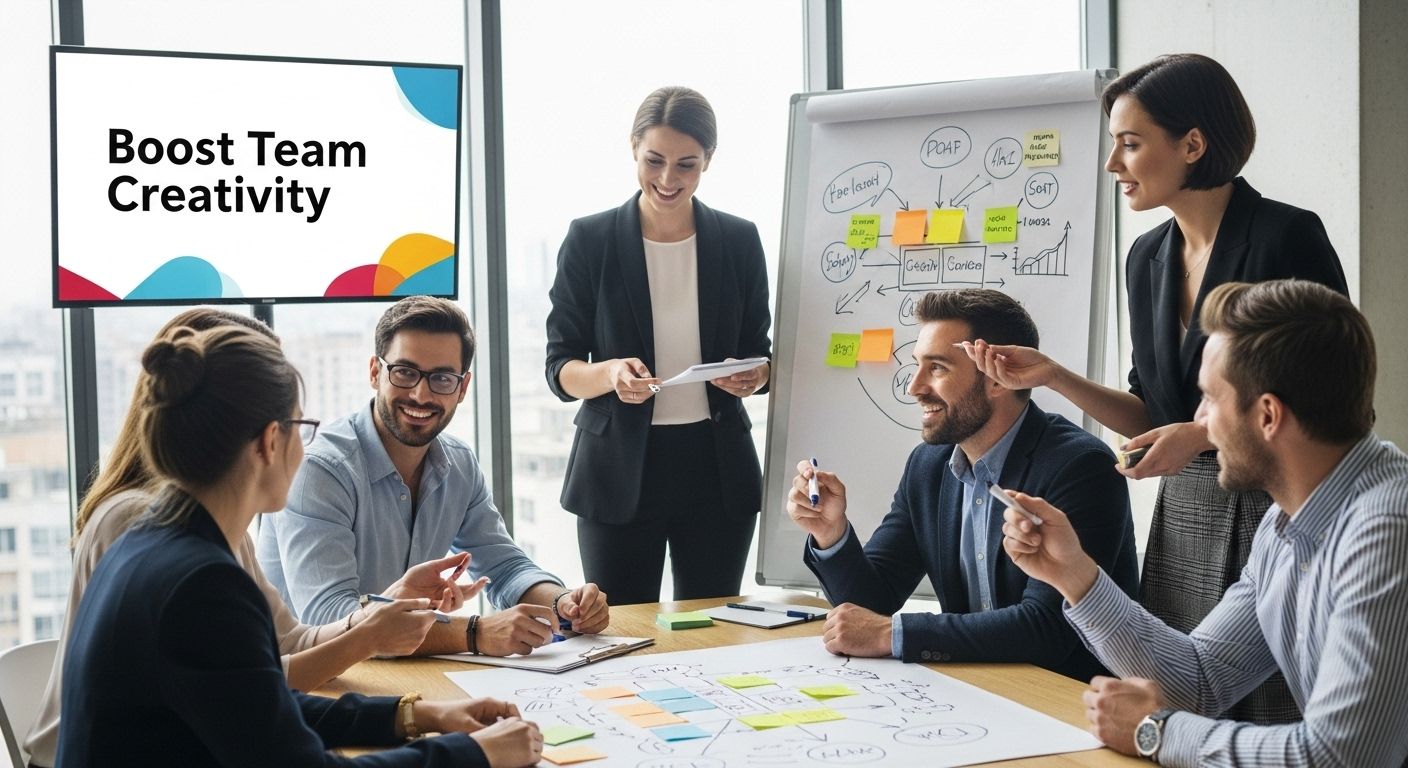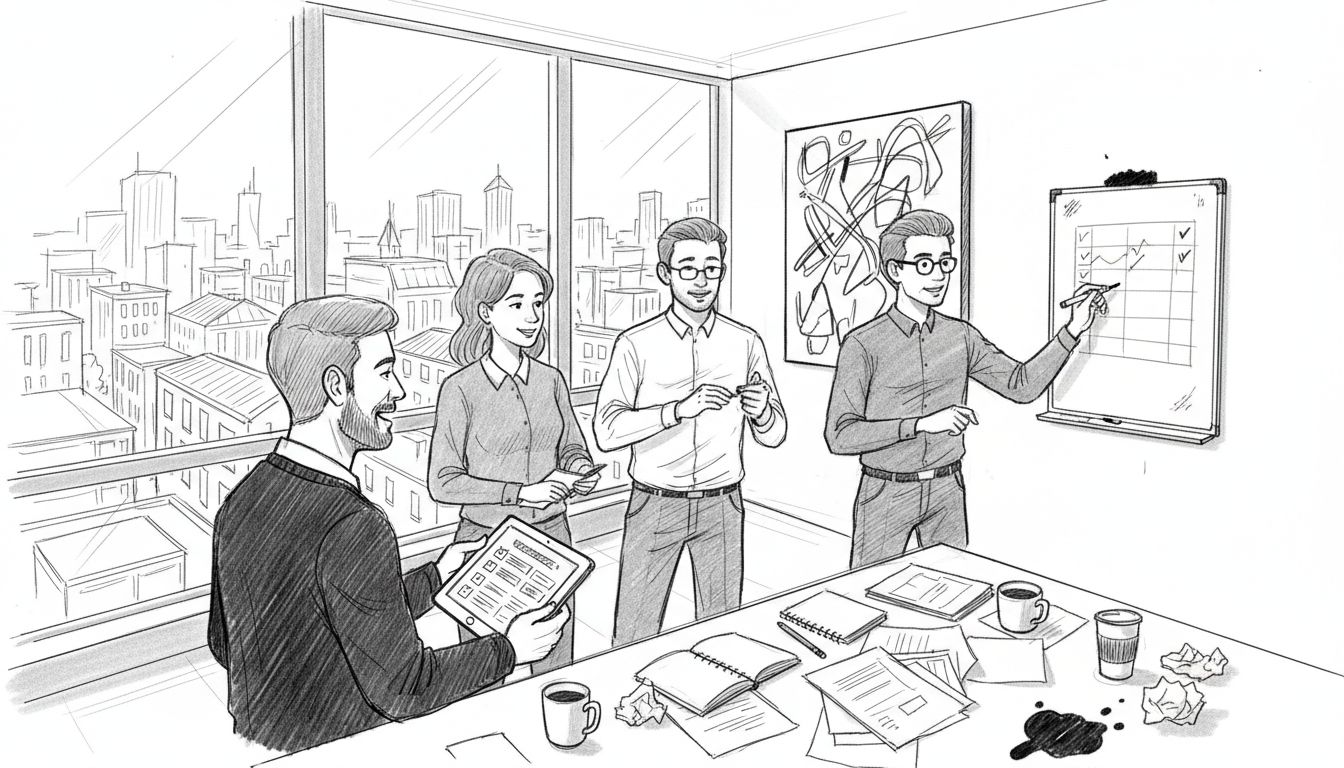Team brainstorming can turn a bland meeting into a hotbed of new ideas, especially when you tap into proven creative strategies. Studies show that sessions capped at just 15-30 minutes spark far more creative solutions than drawn out marathons. Most people expect the best ideas to come from the loudest voices in the room. The real secret is that the biggest breakthroughs often come from quieter teammates—once you create the right space for every idea to land.
Table of Contents
- Key Elements Of Effective Brainstorming Sessions
- Proven Techniques To Spark Creative Ideas
- Overcoming Common Challenges In Brainstorming
- Actionable Tips For Leading Productive Sessions
Quick Summary
| Takeaway | Explanation |
|---|---|
| Create a Judgment-Free Environment | Ensure participants feel safe to share all ideas without fear of criticism. This is essential for fostering creativity. |
| Use Structured Techniques for Idea Generation | Implement approaches like round robin and mind mapping to maintain order and prevent dominance by louder voices. |
| Document All Ideas During Sessions | Record every suggestion made to ensure no valuable contributions are lost and to facilitate evaluation later. |
| Establish Clear Ground Rules | Define explicit guidelines for participation and respect to mitigate psychological barriers and enhance collaboration. |
| Keep Sessions Short and Focused | Limit brainstorming sessions to 15-30 minutes to maintain high energy and prevent fatigue, leading to more productive results. |
Key Elements of Effective Brainstorming Sessions
Effective brainstorming sessions transform ordinary team meetings into powerful creativity engines. By understanding the key elements that drive successful idea generation, teams can unlock remarkable problem solving potential and innovative solutions.
Establishing a Collaborative Environment
Creating the right atmosphere is fundamental to effective brainstorming. According to Northern Illinois University, successful brainstorming begins with clearly presenting the problem or challenge as a concise question. This approach stimulates diverse thinking and encourages participants to approach the issue from multiple angles.
The environment must be judgment free and welcoming. Participants need to feel psychologically safe to share unconventional ideas without fear of criticism. This means establishing ground rules that emphasize respect, openness, and curiosity. Teams should explicitly state that during brainstorming, no idea is considered too wild or impractical.
Structured Idea Generation Techniques
MIT Human Resources recommends specific techniques to maximize creative output. One powerful approach is the round robin method, where each team member contributes an idea in turn, preventing dominant personalities from monopolizing the discussion. Another technique involves using visual aids like flipcharts to capture and organize thoughts in real time.
Additionally, teams can employ methods like mind mapping, where ideas are connected through visual networks, or the 6-3-5 technique where six participants write three ideas in five minutes. These structured approaches prevent brainstorming from becoming an unproductive free for all and ensure systematic idea exploration.
To help you quickly compare popular structured brainstorming techniques discussed in this article, here’s a table summarizing each method, its main features, and its key benefits:
| Technique | Main Features | Key Benefits |
|---|---|---|
| Round Robin | Each member shares ideas in turn | Prevents dominance, ensures equal participation |
| Mind Mapping | Visual network of connected ideas | Encourages divergent thinking, organizes ideas visually |
| 6-3-5 Technique | 6 people write 3 ideas each in 5 minutes | Rapid idea generation, crowdsources quickly |
| Nominal Group Technique | Ideas generated independently, then discussed as a group | Reduces groupthink, allows introverts to contribute |
| Reverse Brainstorming | Flip the problem and explore how to create/worsen it | Reveals hidden issues, prevents solution tunnel vision |
| SCAMPER | Apply 7 prompts: Substitute, Combine, Adapt, Modify, Put to another use, Eliminate, Reverse | Sparks creative modifications, structured yet flexible |
| Anonymous Idea Submission | Ideas collected without revealing their source | Reduces fear of judgment, increases honesty |
Capturing and Evaluating Ideas
Penn State Learning emphasizes the critical importance of recording all contributions during brainstorming. This means documenting every suggestion, no matter how unconventional. Digital tools or physical whiteboards can help track ideas, ensuring nothing gets lost in the moment.
After the initial idea generation phase, teams should implement a structured evaluation process. This typically involves categorizing ideas, identifying potential, and assessing feasibility. The key is to transition from pure creativity to practical implementation strategy. Learn more about collaborative decision making strategies that can help teams effectively assess and prioritize the ideas generated.
Successful brainstorming is not about generating the most ideas but creating an environment where innovative thinking can flourish. By focusing on collaboration, structure, and thoughtful evaluation, teams can transform brainstorming from a routine meeting into a powerful innovation catalyst.

Proven Techniques to Spark Creative Ideas
Creativity is not a mystical talent reserved for a select few but a skill that can be systematically developed and enhanced through strategic techniques. By understanding and implementing proven methods, teams can consistently generate breakthrough ideas and innovative solutions.
Structured Idea Generation Methods
Stanford University highlights the importance of implementing specific rules during brainstorming to enhance creativity. Their research from the Stanford d.school reveals that structured guidelines actually increase psychological safety and participation.
One powerful technique is the nominal group technique (NGT). According to research published in the Journal of Creative Behavior, NGT involves team members generating ideas independently before sharing and discussing them collectively. This approach prevents groupthink and allows introverted team members to contribute equally, leading to more diverse and original ideas.
Additional structured methods include:
- Reverse Brainstorming: Flip the problem by asking how to cause the opposite situation
- SCAMPER Technique: Substitute, Combine, Adapt, Modify, Put to another use, Eliminate, Reverse
- Random Word Association: Introduce a random word to trigger unexpected connections
Psychological Triggers for Innovation
Unlocking creativity requires understanding the psychological factors that stimulate innovative thinking. Creating an environment that encourages risk taking and reduces fear of judgment is crucial. This means establishing a culture where every idea is initially welcomed without immediate criticism.
Psychological safety can be enhanced by:
- Setting clear expectations about non judgmental idea sharing
- Encouraging wild and seemingly impossible suggestions
- Celebrating unique perspectives and unconventional thinking
Digital and Physical Creativity Stimulation
Modern teams can leverage both digital and physical tools to spark creativity. Digital platforms offer collaborative spaces where team members can contribute ideas asynchronously, while physical environments can be designed to promote creative thinking.
Technology enables innovative approaches like virtual whiteboards, mind mapping software, and collaborative documents that allow real time idea generation. Physical spaces can be optimized with:
- Flexible seating arrangements
- Visual inspiration boards
- Color coded idea tracking systems

Explore our collaborative decision making strategies to further enhance your team’s creative potential. By combining structured techniques, psychological understanding, and innovative tools, teams can transform brainstorming from a mundane meeting into a powerful idea generation engine.
Overcoming Common Challenges in Brainstorming
Brainstorming sessions often encounter significant obstacles that can derail creativity and productivity. Understanding these challenges and implementing strategic solutions can transform potentially unproductive meetings into powerful idea generation opportunities.
Identifying and Neutralizing Participation Barriers
Critical Values Research highlights the critical importance of recognizing participation barriers in team settings. One primary challenge is the tendency for dominant personalities to monopolize discussions, which can silence more introverted team members.
To address this issue, teams can implement strategies such as:
- Round Robin Technique: Ensuring each participant gets equal speaking time
- Anonymous Idea Submission: Using digital tools or physical methods to collect ideas without revealing the originator
- Structured Speaking Protocols: Establishing clear guidelines that prevent interruptions and encourage balanced participation
Managing Group Dynamics and Psychological Obstacles
Northern Illinois University emphasizes the significance of defining clear problem statements and participant roles to mitigate psychological barriers. Common obstacles include fear of judgment, groupthink, and lack of psychological safety.
Effective strategies to overcome these challenges involve:
- Creating explicit ground rules that prohibit criticism during idea generation
- Encouraging divergent thinking by celebrating unique and unconventional ideas
- Establishing a non threatening environment where participants feel secure sharing potential solutions
Technical and Logistical Brainstorming Challenges
Group Creativity Resources suggest that technical limitations and logistical constraints can significantly impede brainstorming effectiveness. Remote teams, time zone differences, and technological barriers can disrupt creative flow.
Modern solutions include:
- Utilizing collaborative digital platforms that allow asynchronous idea sharing
- Implementing time zone friendly scheduling
- Creating flexible participation models that accommodate different working styles
Learn about advanced task management techniques to complement your brainstorming strategies. By systematically addressing participation barriers, psychological obstacles, and technical challenges, teams can create more inclusive, productive, and innovative brainstorming environments that consistently generate high quality ideas.
Below is a table summarizing common brainstorming challenges and the specific solutions outlined in the article to overcome them. Use this as a quick reference to troubleshoot your own team sessions.
| Challenge | Solution(s) |
|---|---|
| Dominant personalities monopolize | Round robin, structured protocols, anonymous submission |
| Participation barriers for quiet members | Equal speaking time, anonymous idea sharing |
| Fear of judgment/groupthink | Clear ground rules, non-judgmental environment, celebrate wild ideas |
| Technical/logistical constraints (remote) | Collaborative digital tools, time zone-friendly scheduling, flexible participation models |
| Losing or missing good ideas | Documenting all suggestions with digital/physical tools |
Actionable Tips for Leading Productive Sessions
Leading a productive brainstorming session requires strategic preparation, skillful facilitation, and a deep understanding of group dynamics. Successful leaders transform potential chaos into focused creativity, guiding teams toward meaningful insights and innovative solutions.
Preparation and Session Design
University of South Carolina emphasizes the critical importance of setting a clear focus before initiating any brainstorming session. This means defining specific objectives, establishing transparent ground rules, and creating an environment conducive to open communication.
Key preparation strategies include:
- Developing a concise problem statement
- Preparing visual aids and documentation tools
- Selecting participants with diverse perspectives and complementary skills
- Creating a comfortable physical or virtual space that encourages participation
Effective session design involves carefully structuring the brainstorming process to maximize creativity and maintain engagement. This means planning the session duration, selecting appropriate idea generation techniques, and ensuring all participants understand their roles.
Time Management and Energy Dynamics
Centers for Medicare & Medicaid Services recommends keeping brainstorming sessions relatively short, typically between 15 to 30 minutes, to prevent mental fatigue and maintain high energy levels. Shorter, focused sessions often produce more quality ideas than lengthy, drawn out meetings.
Strategies for maintaining momentum include:
- Setting strict time limits for each stage of brainstorming
- Incorporating brief energizer activities
- Rotating facilitator responsibilities
- Using timer techniques to create a sense of urgency
Creating a Stimulating Creative Environment
South East Technological University highlights the significance of creating a relaxed and positive atmosphere that encourages uninhibited idea generation. This involves using creative tools, establishing principles that welcome wild ideas, and minimizing the fear of failure.
Environmental design techniques include:
- Using visual stimulation tools like markers, paper, or digital whiteboards
- Incorporating playful elements like Lego or creative props
- Establishing a judgment free zone
- Encouraging participants to build upon each other ideas
Explore advanced task management strategies to complement your brainstorming leadership skills. By combining strategic preparation, dynamic time management, and a stimulating creative environment, leaders can transform brainstorming from a mundane meeting into a powerful innovation catalyst that consistently generates breakthrough ideas.
Frequently Asked Questions
What are the key elements of an effective brainstorming session?
The key elements of an effective brainstorming session include establishing a collaborative environment, using structured idea generation techniques, capturing and evaluating ideas, and maintaining a judgment-free atmosphere. These elements foster creativity and ensure that all team members feel safe to share their ideas.
How can I create a judgment-free environment during brainstorming?
To create a judgment-free environment, establish ground rules that emphasize respect and openness. Ensure participants understand that all ideas are welcome, and encourage wild or unconventional suggestions without the fear of criticism. This helps to promote psychological safety among team members.
What techniques can I use to structure idea generation?
You can use various structured techniques for idea generation such as the round robin method, where each participant shares one idea in turn, and mind mapping, which visually connects ideas. Other methods include the 6-3-5 technique, nominal group technique, and SCAMPER, which provide diverse ways to explore and develop ideas systematically.
How can I overcome common challenges in brainstorming sessions?
Common challenges can be overcome by implementing strategies such as the round robin technique to address dominant personalities, using anonymous idea submission to encourage participation from quieter members, and setting clear ground rules to manage psychological barriers. Furthermore, utilizing collaborative digital tools can help tackle logistical challenges in remote brainstorming sessions.
Transform Your Team’s Creative Spark into Seamless Results
Is your team struggling to capture every great idea during brainstorming, only to lose track of them later? Many businesses find it difficult to turn fast-paced creativity into effective action. Missed ideas, lack of structure, and slow follow-up can drain both momentum and morale.

You can keep your best brainstorming breakthroughs visible and actionable with Gammatica’s AI-driven platform. Our automated task management and collaborative tools help you quickly document, track, and assign ideas, integrating them into dynamic Kanban boards, checklists, and structured workflows. Replace lost inspiration with clear next steps, accessible to everyone, whether your team is in-person or remote. If you are ready to eliminate wasted time and bring real order to every creative session, explore the full benefits of Gammatica now. Start building a deliberate, innovative culture today and watch your team’s productivity soar.
Recommended
- Collaborative Decision Making for Leaders: Strategies for 2025 | Gammatica
- How to Manage Tasks Effectively in 2025: Proven Strategies for Leaders | Gammatica
- Project Progress Tracking: Strategies for Success in 2025 | Gammatica
- Automation for Small Businesses: Essential Strategies for 2025 | Gammatica



